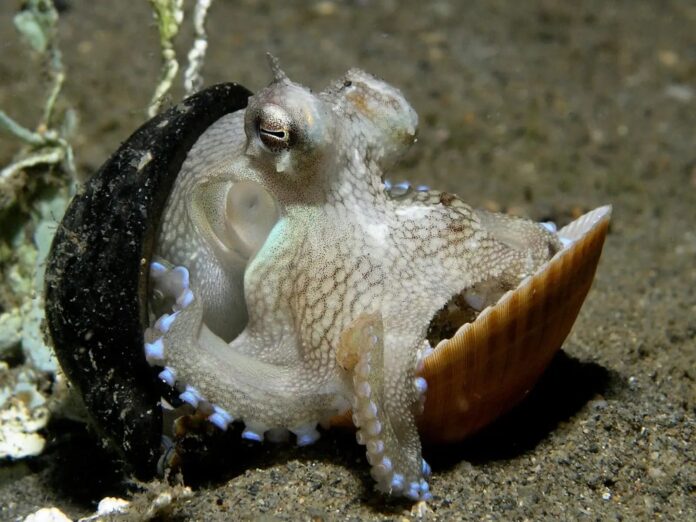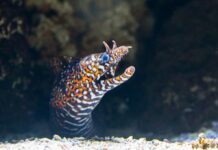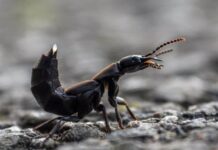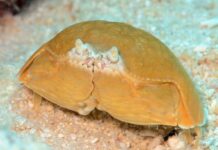How do you define beauty in cephalopods? When it comes to beautiful octopus species, there are so many things combined that bring out the eye-catching appearance. Among around 300 species of octopus across the world, you are going to look at the 7 most striking ones today. From adorable looks to colorful patterns, we have them all for you below.
1Caribbean Reef Octopus
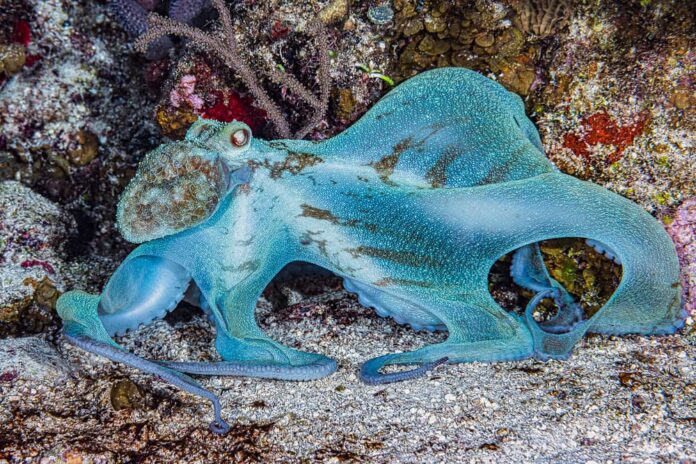
Scientific Name: Octopus Briareus
A Caribbean reef octopus has a large and bulky mantle that can be up to 60 centimeters long, along with its 8 long arms. Its iridescent coloration makes it one of the most beautiful octopus species, but that comes with a twist. It has the ability to change its colors and textures to blend into its surroundings, so it is hard to describe its colors. What we know is that it can change from crimson to green, and from bumpy to smooth within seconds. This special ability to control their skin and muscles makes them nearly impossible to see. Beautiful and loyal, these octopi are monogamous, and they actually mate only once in their lifetime. Males die a few months after mating, and females die shortly after laying the eggs and ensuring that the eggs are well-hidden.
The range of the Caribbean reef octopus is in the Caribbean Islands, the northern coast of South America, and South Florida. This cephalopod lives alone in dens in warm waters around coral reef environments as well as grassy and rocky seabeds. They are territorial, and they will defend their dens from both predators and other octopi. Those areas are full of their favorite meals, including clams, crabs, marine snails, lobsters, polychaetes, and a variety of fish. It hunts by throwing its arms over large pieces of coral while extending its webbing to form a tight cling wrap seal. Nothing can escape from that deadly canopy.
Being a master of disguise is not enough, they actually have some defense mechanisms up their sleeves to deal with predators. It can propel itself away by sucking up volume of water or eject ink to mask its escape. Some of their common predators are dolphins, eels, other octopi, sharks, stingrays, whales, and other large bony fish.
2Coconut Octopus
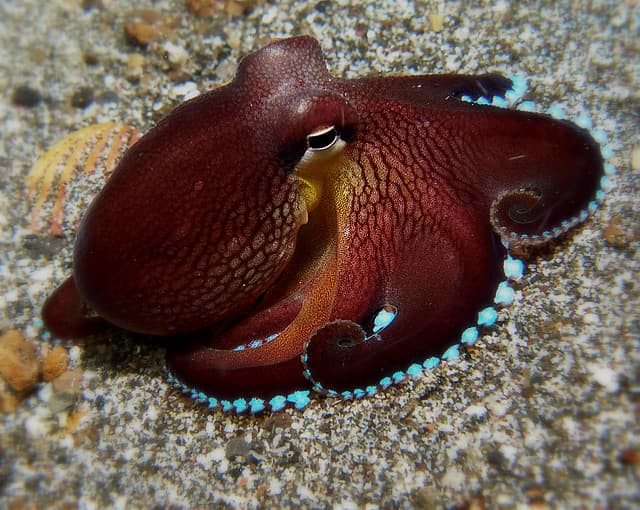
Scientific Name: Amphioctopus Marginatus
A list of beautiful octopus species is incomplete without the adorable coconut octopus. It is a medium-sized cephalopod that grows to a size of 10 centimeters with tentacles of around 30 centimeters long. The colors are usually tan-brown which helps them to blend in with their environments. It has a dark color with lines that resemble veins; hence the nickname “veined octopus”. Along with that, they also have dark markings across their skin and extremely bright suckers. These cephalopods receive their name from the habit of carrying coconut shells under their arms as tools to protect themselves. If a predator approaches, it will assemble its coconut shells around itself and stay safe in there. There are times when coconuts or shells are not available, then they will hide inside beer bottles or other trash.
These cuties are endemic to shallow and tropical waters in the Indian Ocean, the Northwest and Western Pacific Ocean, the Red Sea, and the Southeast Asian Sea. They inhabit subtidal waters as well as mud and sand substrates, where they live in holes or bury themselves in the sand. At the same time, they also frequent bays, lagoons, and other inlets. In these habitats, they actively hunt and feed on clams, crabs, and shrimps at dusk and dawn. All of the 8 tentacles are very wide, and they are useful for catching prey after pouncing on it. As for its sharp beak, it is so strong it can puncture and rip through the exoskeletons of arthropods and crustaceans. As solitary creatures, they live alone throughout their life and they only come together to mate.
3Common Blanket Octopus
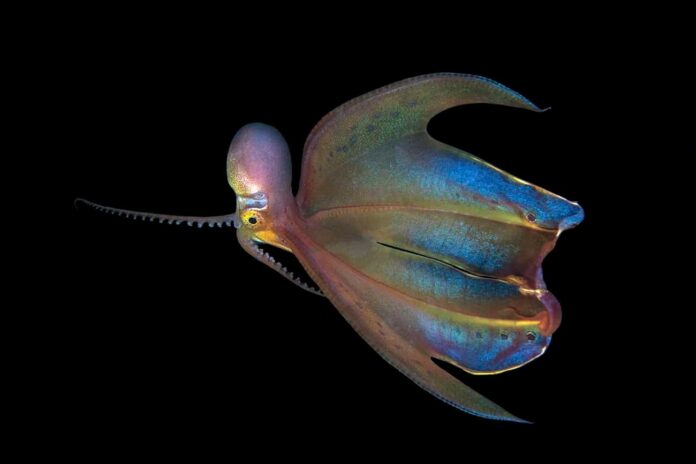
Scientific Name: Tremoctopus Violaceus
A common blanket octopus has a silvery tone on its side along with a blue or dark purple dorsal surface. As for the ventral surface, it is iridescent silvery gold while the web is deep maroon in color. So why the name blanket? Adult female blanket octopi have a webbing between their arms that resembles a blanket, and it is their main feature. The awesome part is that females can unfold this webbing to appear larger in order to intimidate predators. There are 4 blanket octopus species, and each of them has different blanket appearances and colors. While it is common for female octopi to be larger than males, the size difference in this one is extremely extreme. Females usually reach up to 2 meters in length, while males are only 2.4 centimeters. Males also look different from females, having a smooth and bowl-shaped mantle and the blanket is absent.
Blanket octopi live amongst coral reefs in open waters and shallow seas where they hunt for jellyfish and small fish. They are immune to the toxins of many jellyfish, and they commonly rip the jellyfish’s stinging tentacles to use as a weapon. Mostly juveniles, they hold those tentacles with their lateral arms and whip them about to sting their prey. Pretty smart and wild at the same time, right? These cephalopods are nomadic so this beautiful octopus species moves about to different locations every couple of days. With their adaptation to a variety of water temperatures, they live in both subtropical and tropical oceans. All 4 species are classified as Least Concern on the IUCN Red List, and it is good to see these graceful cephalopods thrive.
4Flapjack Octopus
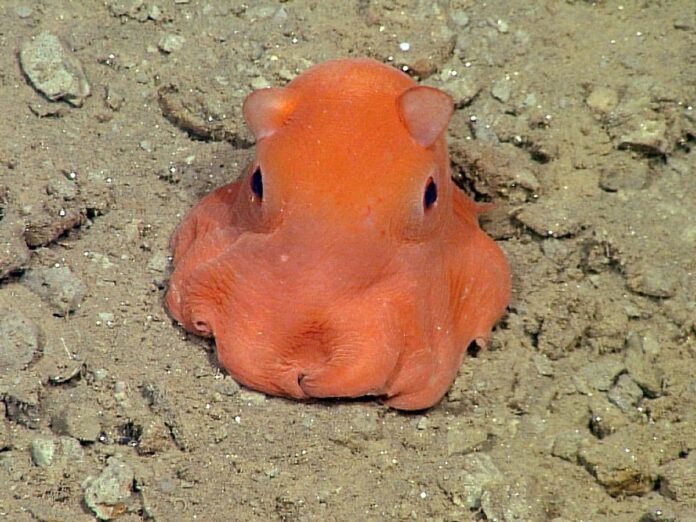
Scientific Name: Opisthoteuthis Californiana
Rather stay on the cute side, a flapjack octopus is probably one of the cutest octopi in the world. Its gelatinous body is pink in color and it has fins above its eyes! However, this beautiful octopus species cannot change its color or texture to camouflage like most octopus species. This tiny adorable little thing reaches a maximum size of 20 centimeters, and it has 8 cute little arms. These arms are affixed together in an umbrella shape, and swims by moving its fins and pulsing its webbed arms. When it swims, it looks like a jelly. And when it floats, it looks like an umbrella. If this is not the cutest ever, I don’t know what is.
Flapjack octopi have a distribution in the northern and northeastern Pacific Ocean, living in the muddy seafloor. Being tiny, they also feed on tiny stuff like small benthic and small crustaceans like copepods, isopods, mysids, and small shrimps. They have finger-like filaments called cirri line in their arms that they use to find food in the mud and rocks. How can something so small and vulnerable survive when it cannot even camouflage? Flapjack octopi are smart, and they simply hide in plain sight. While they appear pink or yellow to our eyes, they are almost invisible to other sea animals. That is because red wavelengths don’t reach the deep sea, so they actually appear dark. And in case a predator approaches, it evades by pulsing its body, propelling itself with its funnel, and using its fins to steer. The current will carry it to safety and away from predators.
5Glass Octopus

Scientific Name: Vitreledonella Richardi
Transparent and vivid, the glass octopus is one of the most interesting and beautiful octopus species that you should not miss. Just like the name suggests, a glass octopus has a see-through body that shows everything. You can literally see its digestive tract, eye, and even optic nerves. A glass octopus has an overall length of 40- 45 centimeters, and they have translucent skin that serves as a defense mechanism. This octopus is so transparent it looks unreal, and it is super eye-catching to look at. Glass octopus lives in the aphotic zone which are deep ocean waters worldwide, both in tropical and subtropical seas. Because of their habitats and elusive behavior, coming across one is very rare. These octopi spend their lives floating in the open sea, and even predators cannot spot them due to their see-through feature.
6Maori Octopus
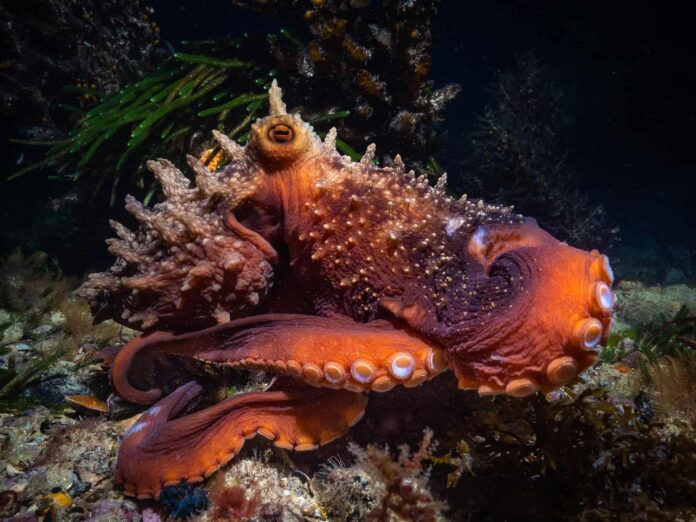
Scientific Name: Macroctopus Maorum
The Maori octopus aka the New Zealand octopus is absolutely a stunning cephalopod with both appearance and personality. It is one of the largest octopus species with a mantle up to 30 centimeters and tentacles that reach one meter long. There are also some specimens whose tentacles can reach as long as 3 meters as well which is absolutely impressive. Those tentacles are long and bulky, and they are extremely powerful. Fun fact, a Maori octopus sheds skin on its suckers to improve its taste buds. This is helpful for them since octopi use their suckers to grip onto prey items, feel their around the reef, smell, and taste. The color pattern of a Maori octopus ranges from orange-brown to dark purple-gray, and there are numerous small iridescent white spots all over.
This beautiful octopus species is native to Australia and New Zealand where they live in temperate waters and temperate-subarctic oceans. In those waters, they inhabit kelp forests, reefs, and seagrass beds, inside large lairs under large boulders. With a size this large, it is without a doubt that it is one of the ferocious predators in the oceans. They feed on abalones, fish, large crabs, mussels, rock lobsters, octopi, and scallops, and they hunt by flaring their arms to trap prey. When catching one, a Maori octopus bites its prey to inject strong paralyzing neurotoxins that immobilize and liquefy the prey’s flesh.
7Paper Nautilus
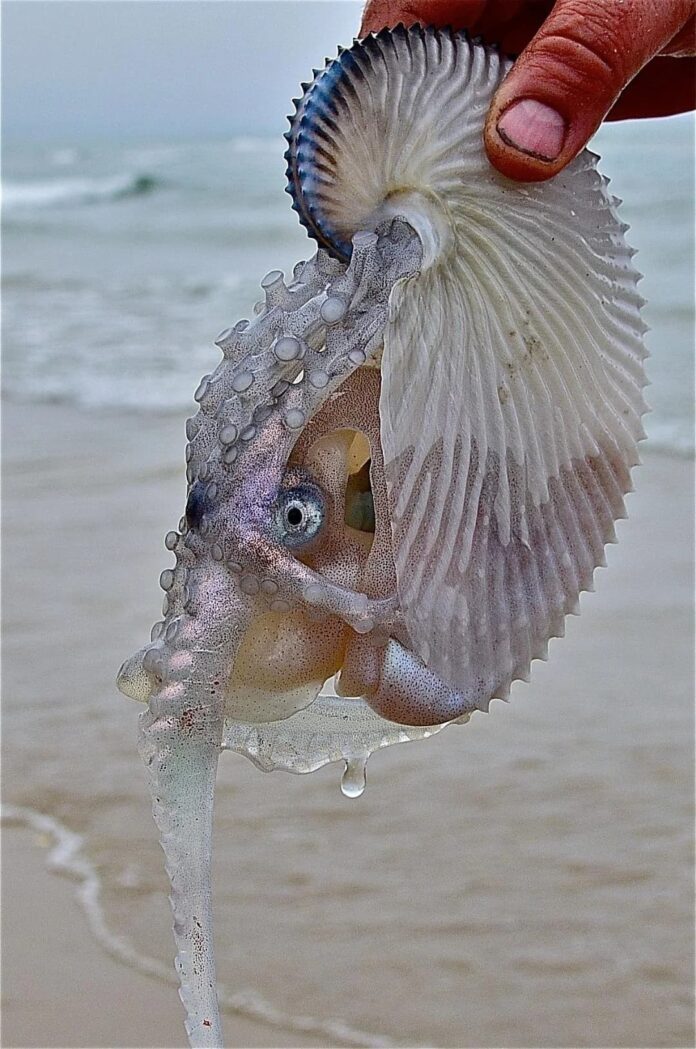
Scientific Name: Argonaut
Crowned as the weirdest octopus in the world, the paper nautilus is one of a kind. A female paper nautilus has a round body that reaches around 10 centimeters along with shells that are up to 30 centimeters. However, a male paper nautilus can only make shells at a size of around 2 centimeters. A female argonaut starts making this shell from when they are around 12 days old. Once she is all grown up, they use that shell as a brooding chamber for her unhatched young.
So what are those shells? The shell has a double keel fringed by two rows of tubercles in which they reside. This shell resembles the appearance of a nautilus; hence the name. It is common to see them protruding their head and tentacles from the opening of the shell. If the case is taken from them, they cannot grow a new one from scratch, and they will die. Both sexes have 8 arms and small webs between those arms. Argonauts are capable of altering their color to blend with their surrounding,s which is a part of their defense mechanism.
This beautiful octopus species has a wide distribution in tropical and subtropical waters worldwide. Being pelagic, paper nautiluses live in the open ocean and close to the surface rather than on the seabed. They usually feed during the day, and they use their tentacles to grab the prey and drag it toward the mouth. Once the prey is in the mouth, it bites it to inject venom from its salivary gland. Speaking of prey, the common meals of the paper nautilus include jellyfish, mollusks, salps, and small crustaceans. And guess what, it has a radula that helps it drill into the shelled prey, frightening, indeed.
Related Post: Wunderpus Octopus Facts

